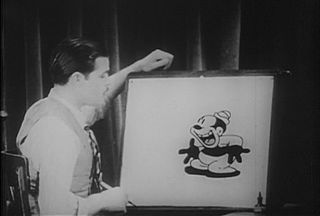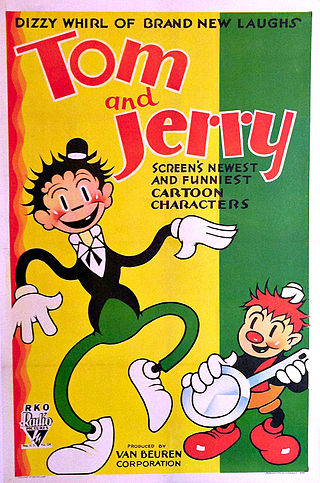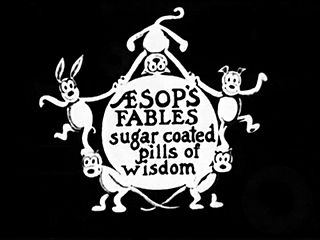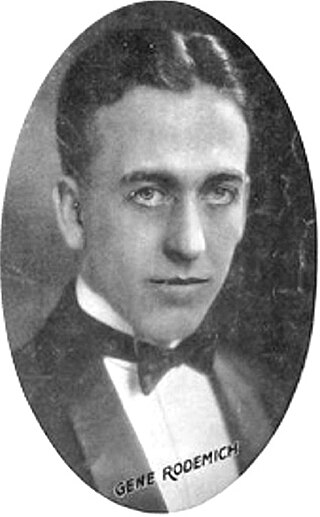Related Research Articles
The golden age of American animation was a period in the history of U.S. animation that began with the popularization of sound synchronized cartoons in 1928, began to decline around 1957, and ended by 1969, when theatrical animated shorts started to lose popularity to the newer medium of television. Animated media from after the golden age were produced on cheaper budgets and with more limited animation techniques between the 1960s and 1970s. The theatrical animation of the golden age peaked in the 1930s and 1940s, while the period is subdivided as the silver age for the rest of its animation produced in the 1950s and 1960s; which includes the latest theatrical animations produced by Walt Disney and Walter Lantz, the latest theatrical cartoons of MGM and Warner Bros., Hanna-Barbera's earliest animated television series and DePatie–Freleng's earliest theatrical cartoons. Furthermore, the history of animation became very important as an artistic industry in the United States.

Terrytoons was an American animation studio in New Rochelle, New York, that produced animated cartoons for theatrical release from 1929 to 1973. Terrytoons was founded by Paul Terry, Frank Moser, and Joseph Coffman, and operated out of the "K" Building in downtown New Rochelle. The studio created many cartoon characters including Fanny Zilch, Mighty Mouse, Heckle and Jeckle, Gandy Goose, Sourpuss, Dinky Duck, Little Roquefort, the Terry Bears, Dimwit, and Luno; Terry's pre-existing character Farmer Al Falfa was also featured often in the series.

Felix the Cat is a cartoon character created in 1919 by Pat Sullivan and Otto Messmer during the silent film era. An anthropomorphic young black cat with white eyes, a black body, and a giant grin, he is often considered one of the most recognized cartoon characters in film history. Felix was the first fully realized animal character in the history of American film animation.
Hugh Harman and Rudolf Ising were an American animation team and company known for founding the Warner Bros. and Metro-Goldwyn-Mayer animation studios. In 1929, the studio was founded under the name Harman-Ising Productions, producing Looney Tunes and Merrie Melodies for Leon Schlesinger from 1930 to 1933. From 1934 to 1938, Harman-Ising produced the Happy Harmonies series, with William Hanna as their employee.

Rudolf Carl Ising was an American animator best known for collaborating with Hugh Harman to establish the Warner Bros. and MGM Cartoon studios during the early years of the golden age of American animation. In 1940, Ising produced William Hanna and Joseph Barbera's first cartoon, Puss Gets the Boot, a cartoon featuring characters later known as Tom and Jerry.

Tom and Jerry are fictional characters that starred in a series of early sound cartoons produced by the Van Beuren Studios, and distributed by RKO Pictures. The series lasted from 1931 to 1933.
Burton F. Gillett was a director of animated films. He is noted for his Silly Symphonies work for Disney, particularly the 1932 short film Flowers and Trees and the 1933 short film Three Little Pigs, both of which were awarded the Academy Award for Best Animated Short Film and both of which were selected for inclusion in the National Film Registry.
Daniel Campbell Gordon was an American storyboard artist and film director who was best known for his work at Famous Studios and Hanna-Barbera Productions. Gordon was one of the first famous film directors. He wrote and directed several Popeye the Sailor and Superman cartoons. Later in his career, he worked on several cartoons featuring Yogi Bear, Huckleberry Hound, and many others. His younger brother, George Gordon, also worked for Hanna-Barbera.

The Floorwalker is a 1916 American silent comedy film, Charlie Chaplin's first Mutual Film Corporation film. The film stars Chaplin, in his traditional Tramp persona, as a customer who creates chaos in a department store and becomes inadvertently entangled in the nefarious scheme of the store manager, played by Eric Campbell, and the store's floorwalker, played by Lloyd Bacon, to embezzle money from the establishment.

The Rink, a silent film from 1916, was Charlie Chaplin's eighth film for Mutual Films. The film co-starred Edna Purviance, Eric Campbell, Henry Bergman, and Albert Austin, and is best known for showcasing Chaplin's roller skating skills. Chaplin's obvious skill on roller skates surprised many of his fans, but Charlie was an experienced performer. As a touring vaudevillian with Fred Karno's pantomime troupe, Chaplin appeared in a roller-skating skit in which he displayed a talent for comedic falls—and the ability to cause other skaters to topple.

Aesop's Fables is a series of animated short subjects, created by American cartoonist Paul Terry. Produced from 1921 to 1933, the series includes The Window Washers (1925), Scrambled Eggs (1926), Small Town Sheriff (1927), Dinner Time (1928), and Gypped in Egypt (1930). Dinner Time is the first cartoon with a synchronized soundtrack ever released to the public. The series provided inspiration to Walt Disney to found the Laugh-O-Gram Studio in Kansas City, Missouri, where he created Mickey Mouse.

Farmer Al Falfa, also known as Farmer Alfalfa, is an animated cartoon character created by American cartoonist Paul Terry. He first appeared in Down On the Phoney Farm (1915), a short Terry cartoon distributed by the Thanhouser Company. Next came a series of shorts produced by Terry for Bray Studios, starting with Farmer Al Falfa's Cat-Tastrophe (1916).

Paul Houlton Terry was an American cartoonist, screenwriter, film director and producer. He produced over 1,300 cartoons between 1915 and 1955 including the many Terrytoons cartoons. His studio's most famous character is Mighty Mouse, and also created Heckle and Jeckle, Gandy Goose and Dinky Duck.

Rainbow Parade is a series of 26 animated shorts produced by Van Beuren Studios and distributed to theaters by RKO between 1934 and 1936. This was the only all-color series produced by Van Beuren, and the final series of the studio.

Winston Singleton Sharples was an American composer known for his work with animated short subjects, especially those created by the animation department at Paramount Pictures. In his 35-year career, Sharples scored more than 700 cartoons for Paramount and Famous Studios, and composed music for two Frank Buck films, Wild Cargo (1934) and Fang and Claw (1935).

Eugene Frederick Rodemich was a pianist and orchestra leader, who composed the music for numerous films in the late 1920s and early 1930s, mostly cartoons and live-action short subjects produced by The Van Beuren Corporation and distributed by RKO Radio Pictures.
Ted Eshbaugh was an American animation filmmaker, best known as one of the first filmmakers to experiment with color sound cartoons in the early 1930s, which included Goofy Goat and The Wizard of Oz.
William Charles Littlejohn was an American animator and union organizer. Littlejohn worked on animated shorts and features in the 1930s through to the 1990s. His notable works include the Tom and Jerry shorts, Peanuts television specials, the Oscar-winning short, The Hole (1962), and the Oscar-nominated A Doonesbury Special (1977). He was inducted into the Cartoon Hall of Fame and received the Winsor McCay Award and garnered lifetime achievement awards from the Annie Awards and the UCLA Film and Television Archive. Director Michael Sporn has called Littlejohn "an animation 'God'."
Pencil Mania is a 1932 animated cartoon in the Van Beuren Studios Tom and Jerry series that breaks the fourth wall of theatre and film. The two main characters become animators in the film, and draw various cartoon scenarios against the blank background, and interact with them. The short was created by John Foster and Vernon Stallings, with synchronization by Gene Rodemich, distributed by RKO Radio Pictures and released through Library Films. The opening credits are played over the song "I'm Looking Over a Four Leaf Clover". Run time is 6:54. It is believed to be in the public domain.

Milton Mouse is an animated character created at Fables Studios for Paul Terry's cartoon series Aesop's Fables. The character was introduced in 1921, and appeared in dozens of cartoon shorts through 1931. Milton often appeared alongside a girlfriend mouse, usually named Rita.
References
- ↑ Lenburg, Jeff (2006). Who's Who in Animated Cartoons. Hal Leonard Corporation. ISBN 9781557836717.
- 1 2 3 "Animation from Van Beuren Studios". Turner Classic Movies. Archived from the original on August 26, 2018. Retrieved August 25, 2018.
- ↑ Michael J. Hayde, Chaplin's Vintage Year, BearManor, 2016. ISBN 978-1593937539
- ↑ A. J. VAN BEUREN, 58, FILM OFFICIAL, DIES. New York Times. November 13, 1938, Sunday p 45
- ↑ THEATER GOSSIP. Evening Independent - Google News Archive - Feb 20, 1938
- ↑ pp. 116–117 Black, James Eric Walt Kelly and Pogo: The Art of the Political Swamp McFarland, 30 Dec 2015